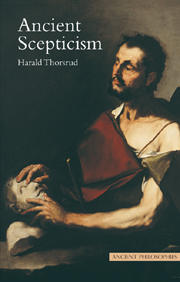Book contents
- Frontmatter
- Contents
- Preface
- Sources and abbreviations
- Chronology
- 1 Introduction
- 2 Pyrrho and Timon: the origin of Pyrrhonian Scepticism
- 3 Arcesilaus: the origin of Academic Scepticism
- 4 Carneades
- 5 Cicero: the end of the sceptical Academy
- 6 Aenesidemus: the Pyrrhonian revival
- 7 Sextus Empiricus: the consistency of Pyrrhonian Scepticism
- 8 Pyrrhonian arguments
- 9 The (ordinary) life of a Pyrrhonist
- Notes
- Guide to further reading
- References
- Index of passages
- Index
2 - Pyrrho and Timon: the origin of Pyrrhonian Scepticism
- Frontmatter
- Contents
- Preface
- Sources and abbreviations
- Chronology
- 1 Introduction
- 2 Pyrrho and Timon: the origin of Pyrrhonian Scepticism
- 3 Arcesilaus: the origin of Academic Scepticism
- 4 Carneades
- 5 Cicero: the end of the sceptical Academy
- 6 Aenesidemus: the Pyrrhonian revival
- 7 Sextus Empiricus: the consistency of Pyrrhonian Scepticism
- 8 Pyrrhonian arguments
- 9 The (ordinary) life of a Pyrrhonist
- Notes
- Guide to further reading
- References
- Index of passages
- Index
Summary
The history of ancient Scepticism officially begins with the enigmatic character, Pyrrho of Elis (c.365–275 bce). Pyrrho wrote nothing himself, so what little evidence we have regarding him comes mostly from the writings of his pupil Timon and a book by a nearly contemporary biographer, Antigonus of Carystus. Only fragments of these works survive in the accounts of other, later writers. Diogenes Laertius, for example, draws from both in his biography of Pyrrho (DL 9.61–108). These later accounts look at Pyrrho through the lens of what Pyrrhonism had become hundreds of years later, so they must be used with caution.
Nevertheless, in seeking to understand the history of Greek Scepticism it is necessary to reconstruct Pyrrho's position. This is so for two reasons. First, the founder of Academic Scepticism, Arcesilaus, was influenced by Pyrrho. And secondly, the founder of neo- Pyrrhonian Scepticism, Aenesidemus (Chapter 6) looked to Pyrrho as an inspirational model of the sceptical life. Clearly we need some account of Pyrrho's views and his character to make sense of this historical influence.
Two recurrent themes in the evidence are Pyrrho's remarkably tranquil life, and his refusal to make any firm determinations about things. There is nothing unusual about a Greek philosopher promoting tranquillity as the proper goal. And there is nothing unusual about the generally sceptical thrust of his view.
- Type
- Chapter
- Information
- Ancient Scepticism , pp. 17 - 35Publisher: Acumen PublishingPrint publication year: 2008



